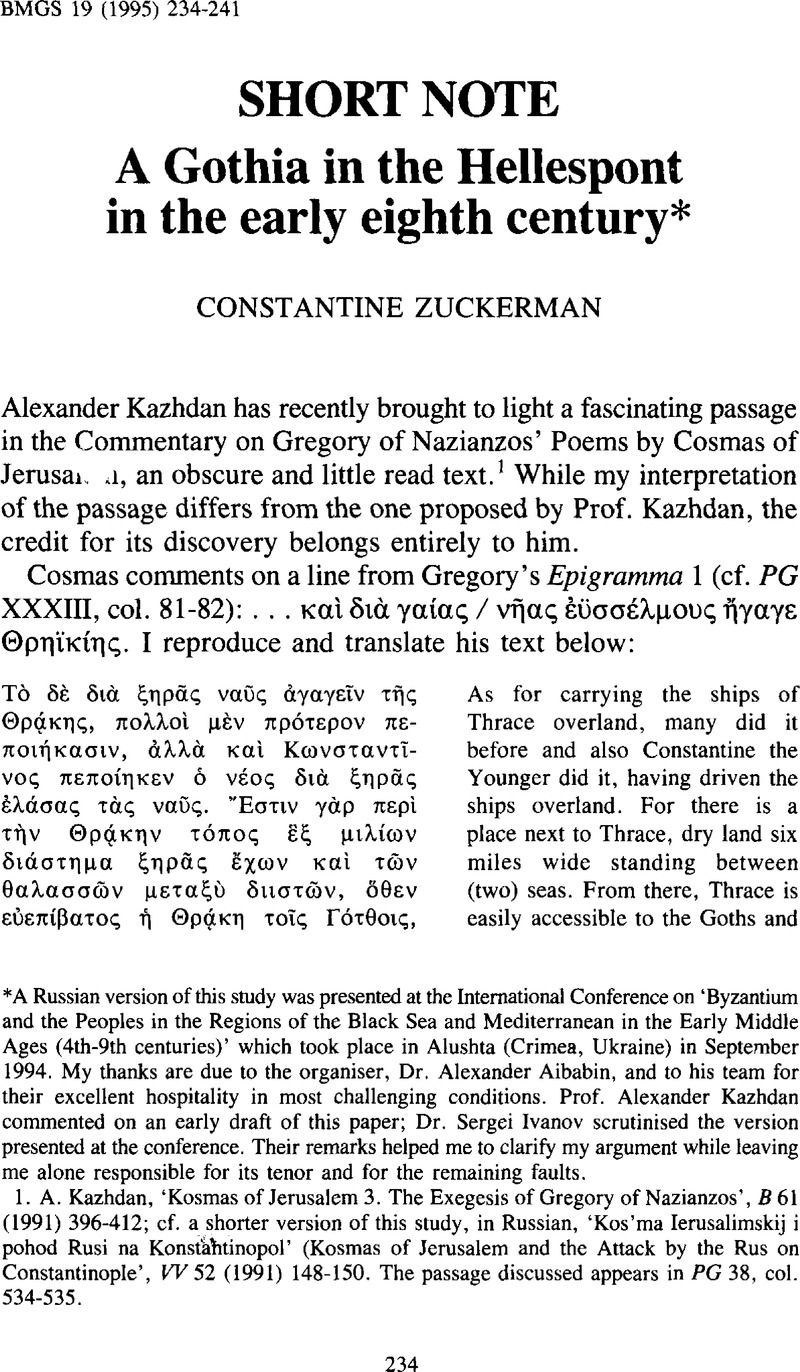Published online by Cambridge University Press: 22 January 2016

1. Kazhdan, A., ‘Kosmas of Jerusalem 3. The Exegesis of Gregory of Nazianzos’, B 61 (1991) 396–412 Google Scholar; cf. a shorter version of this study, in Russian, ‘Kos’ma Ierusalimskij i pohod Rusi na Konst’àhtinopol’ (Kosmas of Jerusalem and the Attack by the Rus on Constantinople’, W 52 (1991) 148-150. The passage discussed appears in PG 38, col. 534-535.
2.
Mai, A., whose edition of the text is reprinted in the PG
Google Scholar, added ©paÇi ![]() . Mai’s Latin translation shows that he could not construct without this correction a phrase which is, in fact, perfectly coherent as it stands.
. Mai’s Latin translation shows that he could not construct without this correction a phrase which is, in fact, perfectly coherent as it stands.
3. I correct the ![]() of the printed text.
of the printed text.
4. Constantine Porphyrogenitus, De Administrando Imperio, 9, 1. 50-55, ed. Gy. Moravcsik-tr. R.J.H. Jenkins2 (Washington 1967), pp.60-61. The use of the ![]() is, however, by no means restricted to the Slavs. The TLG provides scores of references from different periods and regions.
is, however, by no means restricted to the Slavs. The TLG provides scores of references from different periods and regions.
5. My short survey follows the English version of Kazhdan’s study which revises on several points the argument made in the Russian article.
6. Geerard, M., Clavis Patrum Graecorum, II (Tournhout 1974) 194 Google Scholar (3043).
7.
Grumei, V., ‘Quel est l’empereur Constantin le nouveau commémoré dans le Synaxaire au 3 septembre?’, AB
84 (1966) 254–260
Google Scholar. Expectedly enough, there is no evidence for Constantine VII — who had no Constantine among his ancestors or close predecessors — being dubbed ![]() . Kazhdan, p.407, cites, with no identification proposed, a
. Kazhdan, p.407, cites, with no identification proposed, a ![]() in John Xiphilinus’ Miracles of St. Eugenius of Trebizond, ed. O. Lampsides,
in John Xiphilinus’ Miracles of St. Eugenius of Trebizond, ed. O. Lampsides, ![]() (Athens 1984) 90. This could be Constantine VII’s grandson, Constantine VIII.
(Athens 1984) 90. This could be Constantine VII’s grandson, Constantine VIII.
8. The total length of sail through the Straits, from the entrance to the Dardanelles to the Black Sea (along the European coast which is shorter), is little over 300 kilometres and not 300 miles (ca 450 kilometres), as indicated by Cosmas. One can blame this mistake on the fact that the author, a Palestinian monk, probably never made this journey himself.
9. See Durliat, J. and Guillou, A., ‘Le tarif d’Abydos (vers 492)’, BCH 108 (1984) 581–598 Google Scholar; Dagron, G., in Dagron, G. and Feissel, D., ‘Inscriptions inédites du Musée d’Antioche’, TM 9 (1985) 421-461, see 435–455 Google Scholar.
10. The sources are quoted in Stratos, A.N., ‘Siège ou blocus de Constantinople sous Constantin IV, JÖB 33 (1983) 89–107 Google Scholar. Unlike Stratos, I see no reason to doubt that the Arab pressure lasted for seven years — the figure is quoted by Theophanes and Nicephorus who follow a common source as well as in Arab sources (cf. M. Canard, ‘Les expéditions des arabes contre Constantinople dans l’histoire et dans la légende’, Journal Asiatique 208 [1926] 61-121, 77-80, reprinted in idem, Byzance et les musulmans du Proche Orient (London [Variorum] 1973) no. I) — or to affirm, ‘malgré ce que rapportent les sources (my italics, C.Z.), que Fadalah fit une simple expédition de reconnaissance (p.98)’.
11. Theophanes, A.M. 6207, ed. de Boor (Leipzig 1883) 385–386 Google Scholar.
12. Nikephoros Patriarch of Constantinople, Short History, 51 (ed. C. Mango [Washington 1990] 118).
13.
![]()
![]()
![]() , PG 106, col. 756. I have modified the punctuation of the printed text which makes no sense.
, PG 106, col. 756. I have modified the punctuation of the printed text which makes no sense.
14. Zosime, , Histoire nouvelle IV, XXV, 1, ed. Paschoud, F., II (Paris 1979) 287 Google Scholar.
15. AB 18 (1899) 256, cf.Halkin, F., ‘Y a-t-il trois saints Georges évêques de Mytilène et ‘confesseurs’ sous les iconoclastes?’, AB 77 (1959) 464-469, see 467–469 Google Scholar.
16. Kulakovskij, Ju., Istoria Vizantii, III (Kiev 1915) [repr. 1973] 415–416 Google Scholar, against the supposition — defended in the last place by Stein, E., Studien zur Geschichte des byzantinischen Reiches (Stuttgart 1919) 127 Google Scholar — that Gothograecia should be situated as far as Gothia in Crimea.
17.
De Thematibus, IV, 14-17, ed. Pertusi, p.69. On the ![]()
![]() ibid. 1. 12 — which, contrary to what has been suggested by some, is not related to our topic — see
Laurent, V., La vie merveilleuse de Saint Pierre d’Atroa (+837) (Subsidia Hagiographica 29, Bruxelles
1956) 75–76
Google Scholar.
ibid. 1. 12 — which, contrary to what has been suggested by some, is not related to our topic — see
Laurent, V., La vie merveilleuse de Saint Pierre d’Atroa (+837) (Subsidia Hagiographica 29, Bruxelles
1956) 75–76
Google Scholar.
18. Comnène, Anne, Alexiade XV, 4, ed. Leib, B., 3 (Paris 1945) 189 Google Scholar, with Ramsay, W.M., The Historical Geography of Asia Minor (London 1890 [repr. 1962]) 158 and the map opposite 178 Google Scholar.
19. See Haldon, J.F., Byzantine Praetorians. An Administrative, Institutional and Social Survey of the Opsikion and Tagmata, c. 580-900 (POIKILA BYZANTINA 3, Bonn 1984) 96-97, 200-202, 210, 226 Google Scholar and notes.